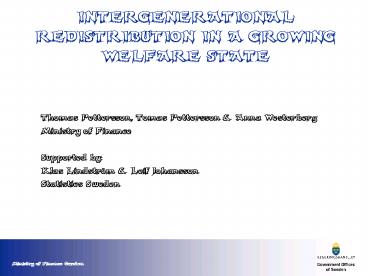INTERGENERATIONAL REDISTRIBUTION IN A GROWING WELFARE STATE PowerPoint PPT Presentation
1 / 13
Title: INTERGENERATIONAL REDISTRIBUTION IN A GROWING WELFARE STATE
1
INTERGENERATIONAL REDISTRIBUTION IN A GROWING
WELFARE STATE
Thomas Pettersson, Tomas Pettersson Anna
Westerberg Ministry of Finance Supported
by Klas Lindström Leif Johansson Statistics
Sweden
2
Financial flows between the household and public
sector 2006
3
Public sector development
- Public transfers and subsidized activities
affecting different parts of the life cycle has
been introduced at different periods - all generations has not received the same support
services - Taxes and contributions has been introduced and
reformed - The age structure of public finances has varied
- Public deficits and surpluses
- Unequal sized cohorts
4
Is there a generational imbalance?
- Hypotheses 1
- The public sector development coincides with the
lifecycle of the 1940s baby boomers - Younger generations has suffered from cut backs
- Hypotheses 2
- The baby boomer entered the labor market at young
ages and will retire late - Younger generations has shorter working lives
5
Methodology
- Calculate lifetime net transfers between
individuals and the public sector aggregate at
cohort level - Historical transfers
- Future transfers
- Include all of the consolidated public finances
- allowing effects of public deficits/surpluses
6
Limitations
- Only direct financial effects
- Public sector transfers only
- Housing effects only through taxes and capital
gains
7
History
- Micro data
- LINDA
- a panel of the Swedish population
- that reaches back to 1968
- including information of market income, direct
taxes and transfers - the panel is artificially extended back to 1930
- Macro data
- National Accounts
- is used to impute components not covered by the
micro data - before 1968 most components are collected from NA
- when available known age-profiles are used,
otherwise equal amount among all adults - tax records are used to impute an income
distribution
8
The future
- Macro data FIMO
- a saving balance model
- that updates NA
- assuming unchanged policy and behavior
- but allowing demographically driven processes to
come into effect - comprises the household, public, enterprise and
foreign sectors - expenditure in one sector is matched by an income
in another sector
- Micro data - SESIM
- a dynamic microsimulation model
- that updates a cross section of the initial
population (1999) - at an annual basis - discrete time
- using mainly estimated equations and some
transition matrices - using techniques for alignment and reduction of
variance - www.sesim.org
9
Lifetime net transfers
10
Lifetime market incomes
11
Lifetime consumption possibilities
12
Lifetime net transfers for high- and low income
earners
13
Main findings
- Redistribution between generations exists..
- 1940ers are the least favored generation, late
1960ers and early 1970ers also have week
positions - 1930ers and 1980ers are the most favored
generations - ..but the redistribution is small.
- public sector redistribution between generations
is small compared to market income as well as to
redistribution within generations

